make available to结构在法律文件中的使用和译法
- 格式:docx
- 大小:15.20 KB
- 文档页数:1
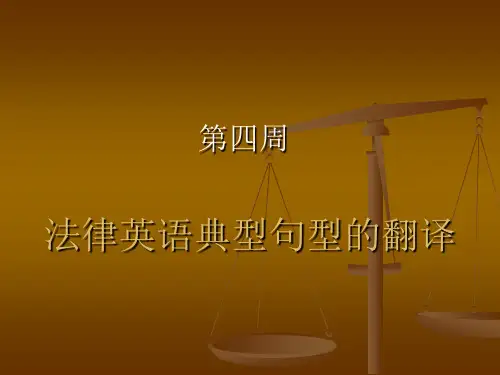
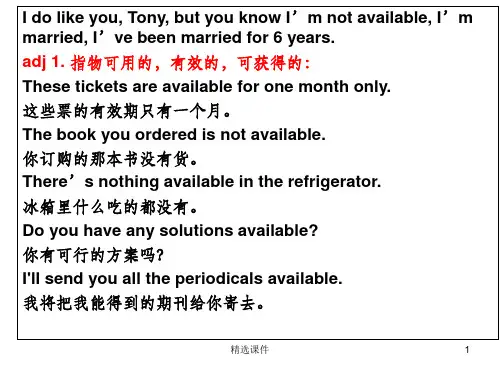

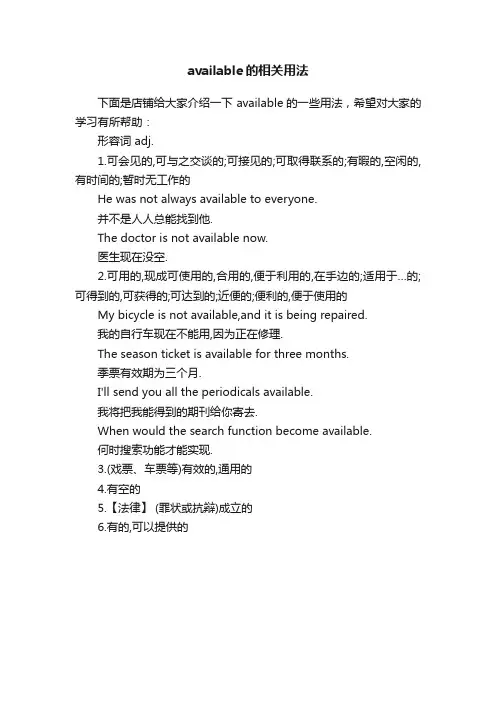
available的相关用法
下面是店铺给大家介绍一下 available的一些用法,希望对大家的学习有所帮助:
形容词 adj.
1.可会见的,可与之交谈的;可接见的;可取得联系的;有暇的,空闲的,有时间的;暂时无工作的
He was not always available to everyone.
并不是人人总能找到他.
The doctor is not available now.
医生现在没空.
2.可用的,现成可使用的,合用的,便于利用的,在手边的;适用于…的;可得到的,可获得的;可达到的;近便的;便利的,便于使用的
My bicycle is not available,and it is being repaired.
我的自行车现在不能用,因为正在修理.
The season ticket is available for three months.
季票有效期为三个月.
I'll send you all the periodicals available.
我将把我能得到的期刊给你寄去.
When would the search function become available.
何时搜索功能才能实现.
3.(戏票、车票等)有效的,通用的
4.有空的
5.【法律】 (罪状或抗辩)成立的
6.有的,可以提供的。
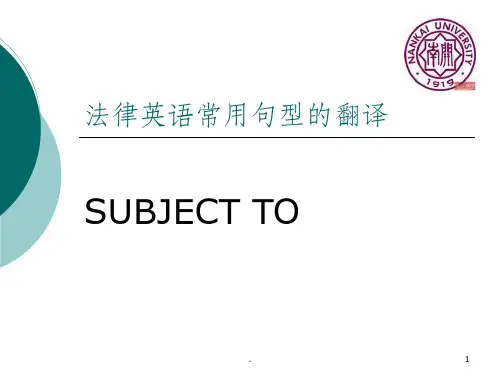
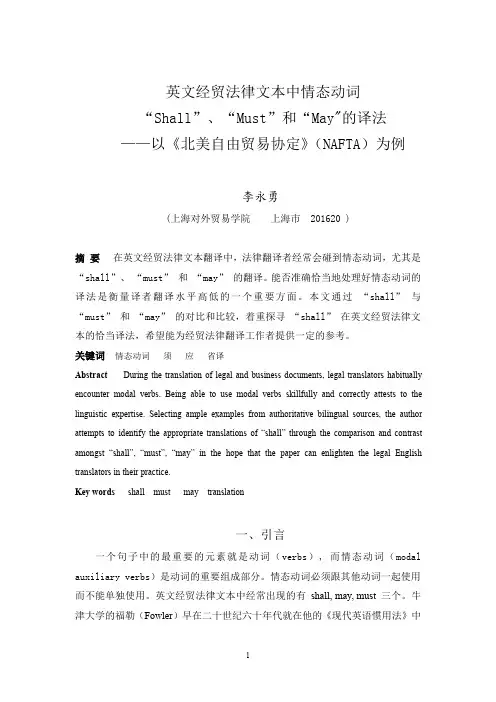
英文经贸法律文本中情态动词“Shall”、“Must”和“May"的译法——以《北美自由贸易协定》(NAFTA)为例李永勇(上海对外贸易学院上海市201620)摘要在英文经贸法律文本翻译中,法律翻译者经常会碰到情态动词,尤其是“shall”、“must”和“may”的翻译。
能否准确恰当地处理好情态动词的译法是衡量译者翻译水平高低的一个重要方面。
本文通过“shall”与“must”和“may”的对比和比较,着重探寻“shall”在英文经贸法律文本的恰当译法,希望能为经贸法律翻译工作者提供一定的参考。
关键词情态动词须应省译Abstract During the translation of legal and business documents,legal translators habitually encounter modal verbs.Being able to use modal verbs skillfully and correctly attests to the linguistic expertise.Selecting ample examples from authoritative bilingual sources,the author attempts to identify the appropriate translations of“shall”through the comparison and contrast amongst“shall”,“must”,“may”in the hope that the paper can enlighten the legal English translators in their practice.Key words shall must may translation一、引言一个句子中的最重要的元素就是动词(verbs),而情态动词(modal auxiliary verbs)是动词的重要组成部分。
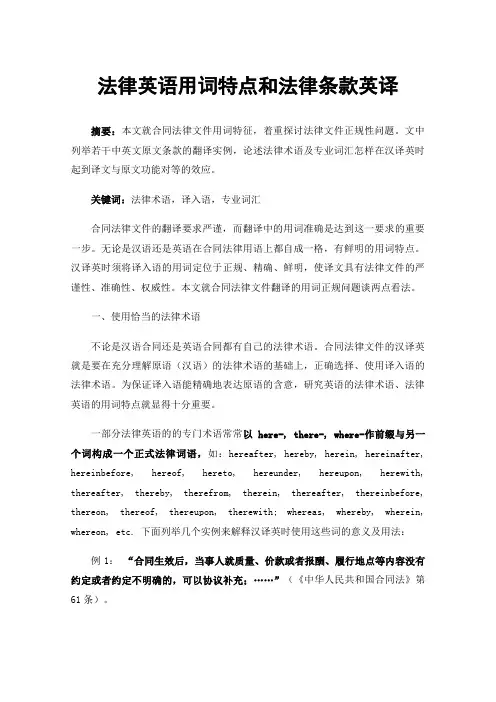
法律英语用词特点和法律条款英译摘要:本文就合同法律文件用词特征,着重探讨法律文件正规性问题。
文中列举若干中英文原文条款的翻译实例,论述法律术语及专业词汇怎样在汉译英时起到译文与原文功能对等的效应。
关键词:法律术语,译入语,专业词汇合同法律文件的翻译要求严谨,而翻译中的用词准确是达到这一要求的重要一步。
无论是汉语还是英语在合同法律用语上都自成一格,有鲜明的用词特点。
汉译英时须将译入语的用词定位于正规、精确、鲜明,使译文具有法律文件的严谨性、准确性、权威性。
本文就合同法律文件翻译的用词正规问题谈两点看法。
一、使用恰当的法律术语不论是汉语合同还是英语合同都有自己的法律术语。
合同法律文件的汉译英就是要在充分理解原语(汉语)的法律术语的基础上,正确选择、使用译入语的法律术语。
为保证译入语能精确地表达原语的含意,研究英语的法律术语、法律英语的用词特点就显得十分重要。
一部分法律英语的的专门术语常常以here-, there-, where-作前缀与另一个词构成一个正式法律词语,如:hereafter, hereby, herein, hereinafter, hereinbefore, hereof, hereto, hereunder, hereupon, herewith, thereafter, thereby, therefrom, therein, thereafter, thereinbefore, thereon, thereof, thereupon, therewith; whereas, whereby, wherein, whereon, etc. 下面列举几个实例来解释汉译英时使用这些词的意义及用法:例1:“合同生效后,当事人就质量、价款或者报酬、履行地点等内容没有约定或者约定不明确的,可以协议补充;……”(《中华人民共和国合同法》第61条)。
翻译此条款时,应从语内译入手,因该条款暗含一个条件句:“如果合同生效后,当事人就……约定不明确的,”其主句是“可以协议补充;……”因此可以译为:If, after the contract made by and between the parties becomes effective, there is no agreement therein on the terms and provisions regarding quality, price or remuneration and place of performance, etc. or such agreement is unclear, the parties may, through consultation, agree upon supplementary terms and provisions.译文there is no agreement后面用了therein,为agreement下了明确的界说,指agreement in the contract,因therein表示 in that; in that particular context; in that respect之意,在此它指上文所指的范围。

情态动词在法律文件翻译中的表达技巧在法律文件的翻译过程中,准确表达原文的含义是至关重要的。
情态动词在英文法律文件中扮演着重要的角色,它们用于表达推测、可能性、义务等概念。
本文将探讨情态动词在法律文件翻译中的表达技巧,并给出一些实用的翻译建议。
一、介绍情态动词情态动词是用来表达可能性、必要性、能力、意愿等情态意义的一类动词。
在法律文件中,情态动词的使用非常频繁,它们可以表达立场、推断、建议、命令等含义。
常见的情态动词包括"can", "could", "may", "might", "shall", "should", "will", "would", "must"等。
二、情态动词的翻译技巧1. 准确理解情态动词的语义在翻译法律文件时,准确理解情态动词的语义对于确保翻译的准确性至关重要。
不同的情态动词具有不同的含义和用法,因此必须根据上下文来确定其准确的翻译。
举个例子,"shall"通常用于表达义务和命令,而"may"则表示许可和可能性。
因此,在翻译过程中,需要根据上下文的语义来选择合适的译词。
2. 注意情态动词的时态和语态情态动词在时态和语态的使用上也需要特别注意。
在英语中,情态动词本身没有时态和语态的变化,它的时态和语态都由其后面的动词来决定。
举例来说,"should have done"表示过去应该做某事,"will be done"表示将来会被做某事。
因此,在翻译时,要注意根据上下文来确定具体的时态和语态。
3. 确保翻译的准确性和规范性在法律文件的翻译中,准确性和规范性非常重要。
情态动词的翻译要准确传达原文的意思,并符合法律用语的规范。
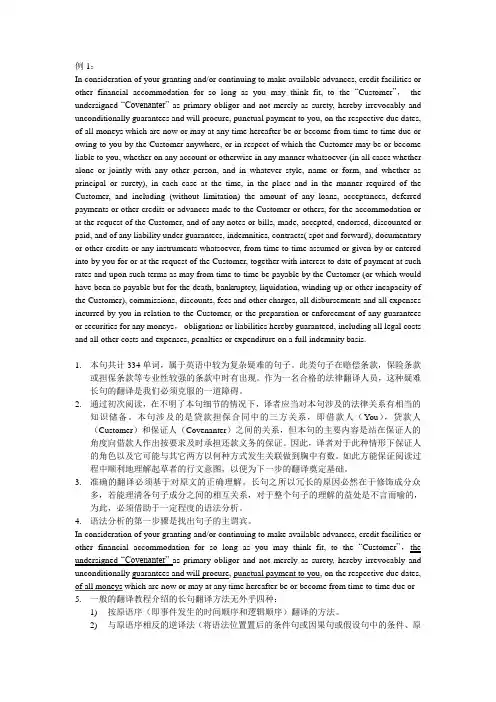
例1:In consideration of your granting and/or continuing to make available advances, credit facilities or other financial accommodation for so long as you may think fit, to the “Customer”,the undersigned “Covenanter”as primary obligor and not merely as surety, hereby irrevocably and unconditionally guarantees and will procure, punctual payment to you, on the respective due dates, of all moneys which are now or may at any time hereafter be or become from time to time due or owing to you by the Customer anywhere, or in respect of which the Customer may be or become liable to you, whether on any account or otherwise in any manner whatsoever (in all cases whether alone or jointly with any other person, and in whatever style, name or form, and whether as principal or surety), in each case at the time, in the place and in the manner required of the Customer, and including (without limitation) the amount of any loans, acceptances, deferred payments or other credits or advances made to the Customer or others, for the accommodation or at the request of the Customer, and of any notes or bills, made, accepted, endorsed, discounted or paid, and of any liability under guarantees, indemnities, contracts( spot and forward), documentary or other credits or any instruments whatsoever, from time to time assumed or given by or entered into by you for or at the request of the Customer, together with interest to date of payment at such rates and upon such terms as may from time to time be payable by the Customer (or which would have been so payable but for the death, bankruptcy, liquidation, winding-up or other incapacity of the Customer), commissions, discounts, fees and other charges, all disbursements and all expenses incurred by you in relation to the Customer, or the preparation or enforcement of any guarantees or securities for any moneys,obligations or liabilities hereby guaranteed, including all legal costs and all other costs and expenses, penalties or expenditure on a full indemnity basis.1.本句共计334单词,属于英语中较为复杂疑难的句子。
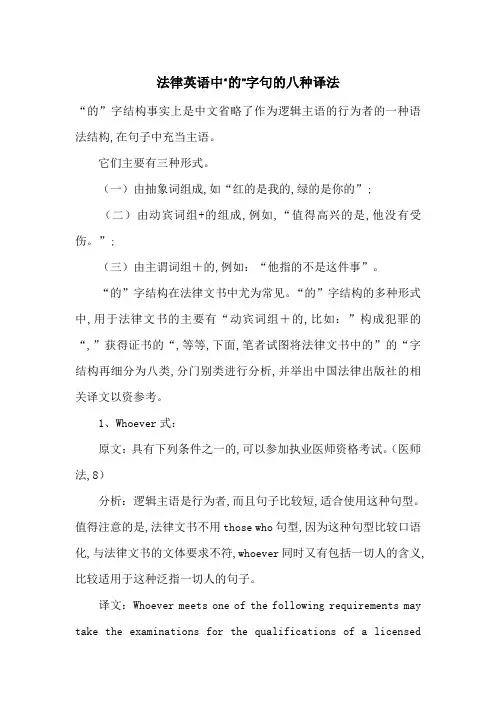
法律英语中“的”字句的八种译法“的”字结构事实上是中文省略了作为逻辑主语的行为者的一种语法结构,在句子中充当主语。
它们主要有三种形式。
(一)由抽象词组成,如“红的是我的,绿的是你的”;(二)由动宾词组+的组成,例如,“值得高兴的是,他没有受伤。
”;(三)由主谓词组+的,例如:“他指的不是这件事”。
“的”字结构在法律文书中尤为常见。
“的”字结构的多种形式中,用于法律文书的主要有“动宾词组+的,比如:”构成犯罪的“,”获得证书的“,等等,下面,笔者试图将法律文书中的”的“字结构再细分为八类,分门别类进行分析,并举出中国法律出版社的相关译文以资参考。
1、Whoever式:原文:具有下列条件之一的,可以参加执业医师资格考试。
(医师法,8)分析:逻辑主语是行为者,而且句子比较短,适合使用这种句型。
值得注意的是,法律文书不用those who句型,因为这种句型比较口语化,与法律文书的文体要求不符,whoever同时又有包括一切人的含义,比较适用于这种泛指一切人的句子。
译文:Whoever meets one of the following requirements may take the examinations for the qualifications of a licenseddoctor.(医师法,7)2、Anyone who 式:原文:具有高等学校医学专科或者中等专业学校医学专业学历,在执业医师指导下,在医疗、预防、保健机构中试用期满1年的,可以参加执业助理医师资格考试。
(医师法,10)分析:anyone who 与whoever表面看来没有什么区别,但是细辩之下,它们的适用范围还是有一些不同,anyone who 用来指称具备一定条件的人,并不是泛指所有的人,如whoever那样;anyone who 另外一点与whoever不同的地方是,anyone who是个定语从句,后边可以带好几个并行成分的句子而读者读起来不感吃力,这点whoever是自叹不如的,大家在决定用whoever还是anyone who 之前一定要仔细分析句型,然后再下笔。
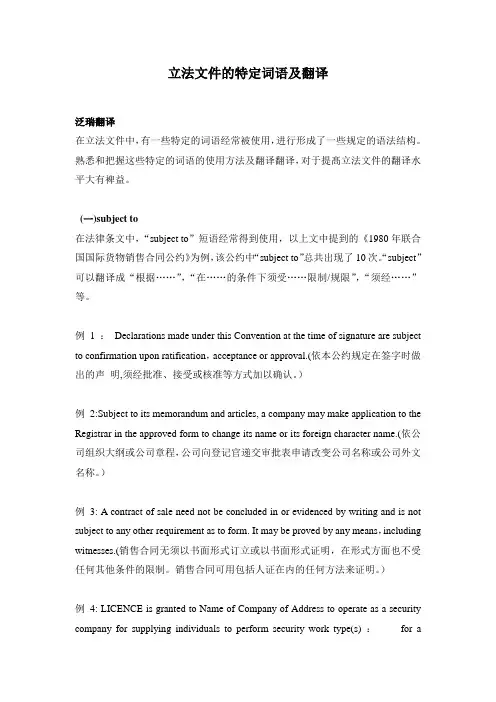
立法文件的特定词语及翻译泛瑞翻译在立法文件中,有一些特定的词语经常被使用,进行形成了一些规定的语法结构。
熟悉和把握这些特定的词语的使用方法及翻译翻译,对于提髙立法文件的翻译水平大有裨益。
(一)subject to在法律条文中,“subject to”短语经常得到使用,以上文中提到的《1980年联合“subject”国国际货物销售合同公约》为例,该公约中“subject to”总共出现了10次。
可以翻译成“根据……”,“在……的条件下须受……限制/规限”,“须经……”等。
例1 :Declarations made under this Convention at the time of signature are subject to confirmation upon ratification,acceptance or approval.(依本公约规定在签字时做出的声明,须经批准、接受或核准等方式加以确认。
)例2:Subject to its memorandum and articles, a company may make application to the Registrar in the approved form to change its name or its foreign character name.(依公司组织大纲或公司章程,公司向登记官递交审批表申请改变公司名称或公司外文名称。
)例3: A contract of sale need not be concluded in or evidenced by writing and is not subject to any other requirement as to form. It may be proved by any means,including witnesses.(销售合同无须以书面形式订立或以书面形式证明,在形式方面也不受任何其他条件的限制。
法律文件中的中英文翻译技巧与注意事项在国际交流与合作日益频繁的今天,法律文件的翻译显得尤为重要。
无论是商务合同、法律文件或者法律条款等,准确无误的中英文翻译都至关重要,以确保各方的权益得到有效保障。
本文将从几个方面探讨法律文件的中英文翻译技巧与注意事项。
一、遵循法律文本写作规范无论是中文还是英文的法律文件,在翻译时都应遵循相应的法律文本写作规范。
在翻译中文法律文件时,应注意使用正式、准确的词汇和句式,避免使用口语化的表达方式。
对于英文法律文件的翻译,应使用具有法律专业知识的英语词汇和语法结构,遵循英文法律文本写作规范。
二、注意法律术语的准确翻译法律术语是法律文件中的关键内容,其翻译必须准确无误。
在翻译中,应遵循专业的法律术语翻译规范,确保准确表达原文的意思。
对于一些无法直接对应的法律术语,可以使用括号注释的方式,给出相应的解释,并在文中对其进行统一。
三、注意法律条文的逻辑结构法律文件中的法律条文通常具有严谨的逻辑结构和层次关系。
在翻译法律条文时,应准确把握原文的逻辑结构,避免在翻译中引入歧义或改变原文的意思。
可以通过使用标点符号和分段来准确体现原文的逻辑结构。
四、考虑不同的法律体系和文化差异中英两种不同的法律体系和文化背景会导致法律概念和表达方式的差异。
在翻译法律文件时,需要充分考虑这些差异,确保翻译结果在不同的法律体系和文化环境下都能准确表达原文的含义。
可以通过参考法律条文和解释、法律案例和常见翻译技巧等途径来应对这些差异。
五、确保语言简练易懂尽管法律文件通常使用严肃正式的语言,但也应保持简练易懂,以确保翻译结果易读易懂。
避免使用过于复杂的句子结构和冗长的表达方式,以免给读者造成理解上的困难。
在保持法律文本的准确性的前提下,可以适当借鉴通俗语言或者解释性语句来帮助读者理解。
六、注重术语一致性和一致性在整个法律文件的翻译中,要注意术语的一致性和一致性。
确保相同的法律术语在不同部分的翻译中一致,并与相关法律文件和先例保持一致。
at its sole discretion结构在法律文件中的使用和译法
discretion在法律英语中的含义是“自由裁量权”,但是其在法律英语中基本不会单独出现,常见的结构为at its sole discretion。
1例句一
Either party may, at its sole discretion, assign the whole or any part of the contract or any benefit or interest in or under the contract, provided a prior notice of the same shall be given to the other party.
合同的任何一方都可以自行决定全部或部分转让本合同,或转让本合同项下的利益和权益,但应提前通知合同另一方。
2例句二
CRO shall use only the labeling for the IPs which is or has been provided by Sponsor, unless otherwise permitted, in each instance, by Sponsor, at its sole discretion, in advance and in writing.
CRO仅可使用委托方提供或曾经提供的试验用药品标签,除非在各个情况下,委托方自行决定事先书面批准。
以上仅代表旗渡观点,欢迎批评指正或讨论交流。
here/there/where+介词等古体词的释义及例子在正规公文、法律文件中,经常会遇到由here/there/where+介词构成的副词。
这些副词的使用突出地反映了中英语言习惯以至思唯方式的差异。
其实,这些副词并不能算是什么法律术语,也不应该是很以难掌握的。
规则简单得很:here + prep. = prep. This/thesethere + prep. = prep. That/thosewhere + prep. = prep. What/which例如:hereby = by (making) this (document, contract, deed, letter, etc. )在介绍信的开头,经常会这样写:"I hereby certify that...", 中文常可译成“兹证明……”,其实也就是“I, by writing this letter, certify that..."又如:thereafter = after that (time, event, etc.)the confidentiality shall remain in effect throughout the term of this contract and for a period of three years thereafter. 就是说保密条款在整个合同期以及合同期满后的三年内有效。
里面的thereafter 就是after the term of the contract.再如:I enclose a notice wherein arrangements are detailed. 这里的"wherein" 完全可以换成"in which".另外,还有一些组合,如:in respect of; in respect thereofin respect of 释义: 关于用法: 法律文件常用语,比about, concerning, as regards正式in respect thereof 释义: 关于(上文已提及的事项) 用法: 例如表示“承包人已在其最终报表中,包括了对此事的索赔”,可以说“the contractor has included a claim in respect thereof in his Final Statement”,这里“in respect thereof”表示“in respect of the matters”。
法律英语中英汉互译的翻译理论与具体实践作者:韦骥刘冬冬王宗宽来源:《管理观察》2009年第25期摘要:此篇论文尝试探讨了法律翻译的一个方面,即法律翻译中的用词原则。
在第—部分中,作者对于法律词汇翻译中的普遍原则做出了介绍并且用例证进行了分析。
在第二部分中,作者通过一些事例和引用具体的法律条文阐述了法律词汇翻译中的特殊词的使用规则。
第三部分为结论部分,在这一部分中,作者表明了这些原则对于法律英语的翻译带来的积极效果,并且对于后续研究进行了展望。
关键词:法律英语翻译法律英语原则选词引言法律是一个国家重要的组成部分。
随着国家交流的日趋频繁,了解他国的法律变得尤为重要。
入世之后,中国与世界建立了更加紧密的联系。
因此,法律英语和法律翻译在国际商贸等对外事务上面发挥着越来越重要的作用。
法律翻译因在历史上口语的不可记录性而无法准确追溯,但有史记载的法律翻译最早可以追溯到十七世纪在南非的殖民时期。
那次庭审涉及一件凶杀案,诉讼各方有多种语言背景。
而当时法庭在决定哪一方诉讼人有权享有法庭翻译服务时,依据的不是各方的语言需求而是阶级,即说英语的贵族才有权享有翻译服务。
1.法律词汇翻译中的普遍原则1.1避免口语化和非正式用语法律的严肃性来源于其自身的不可更改与不可质疑特性。
如果法律的翻译不清晰明确,那么对于法条的理解分歧将会在法庭上引起无休止的争辩。
这种争辩最终会导致案件庭审被迫终止,因为争辩的中心议题已经不再和案件有关而仅仅是对于法条的理解不同。
最终的解决方案只能是有更高层级的法律部门释法或者颁布法律的修订版本。
因此,法律的翻译者们一定要尽可能的选用不可置辩的词汇和正式的法律用语来避免产生歧义。
例如,在法律条文中,“commence”通常被使用,而并非口语化的"begin/start”;“demonstrate”被用来替代“show”;“proceed”被用来替代“g0”;“render”被用来替代“make”;“purchase”被用来替代“buy”;“modify/alter”被用来替代“change”;“provided that”被用来替代“but”;“advise”被用来替代“ten”;“in accordance with”被用来替代“according to”;“employ”被用来替代“use”;“sequent”被用来替代“after”。
应用文体对比与分析对《Deed of Covenants and Guarantee》英译文的对比赏析——从语篇角度对比分析法律文体翻译1.应用文体1.1应用文体:应用文体是人们在日常工作和社会生活中为处理公私事务时所常用的具有直接使用价值和某种固定程式的各种文章的总称,包括人们用来解决和处理日常工作、学习、生活中的实际事务和问题、有直接应用价值、有约定俗成表达要求、行文简洁的各类文章。
它是人们进行思想交流、情报互通、问题解决和事务处理的实用性工具。
应用文体是一种用途非常广泛的文体,从语言较随便的便条、语言简明的电报等到语言极其规范的公函、合同、协议等,都属于应用文体的范畴。
1.2应用文体的特点:应用文体具有以下几个共同的特点:文体的实用性、内容的真实性、体式的规范性和语言的简明性。
1.2.1文体的实用性:应用文体的实用性是指该类文体在处理公共事务和私人事务中具有实际应用的价值,它包括内容的现实性和时效性。
1.2.2内容的真实性:应用文体内容的真实性是指该类文章的内容必须是以事实为依据,不得虚构和杜撰,文中所涉及的事实和数据材料等都要真实、准确,不得有任何的艺术加工。
1.2.3应用文体的体式规范性是指该类文体因目的不同而需要选用不同的文种和适应不同的格式要求。
1.2.4应用文体语言的简明性是指为了节约时间,提高办事效率,该类文章应该以言明事实、解决问题为主旨,在语言上力求简洁、明确,避免使用一些不切实际的赘述。
1.3应用文体翻译:应用文体翻译包括除文学翻译与权威性学术著作之外的所有文本的翻译,包括科技、经济、法律、旅游、广告、公函以及其他应用性文本(如产品说明书、可行性报告研究、履历、菜谱等)。
1.4应用文体翻译的基本原则:应用文是人们在生产和生活过程中进行交往,相互传递信息的一种文体形式。
应用文体的基本功能是荷载人类社会的规约性信息。
与文学作品翻译相比,应用文体翻译的本质在于“信息”的传递,强调真实性,重视信息传达的效度。
英语和汉语是两种不同的语⾔,但在句⼦结构上毕竟还有相同点,⼤体上都具有是“主、谓、宾”的基本框架。
只要英语句⼦可以按其原有的成分排列顺序转换成结构⼤体相同的汉语句⼦,翻译时就应当照办,⽽不必另起炉灶,更不能随意偏离翻译的基本原则,把翻译当作释义(paraphrase)。
按汉语的时间先后和逻辑顺序翻译 如果⼀个英语句⼦⽆法照着原有顺序翻译,就不得不考虑将原句的结构拆开,根据原义⽤汉语重新整合,以时间先后,因果、假设等逻辑关系相继译成⼀句或⼏句意思连贯、内容完整的句⼦。
(a)The enduring significance of the Shanghai Communique is symbolized by the fact that two of the participants in the ceremony fifteen years ago –Ambassadors Han Xu and Winston Lord – are now charged with even greater responsibilities for promoting good relations between our two countries. 15年前,曾参加上海公报签字仪式的两位⼈⼠,韩叙⼤使和温斯顿?洛德⼤使,现在都肩负着促进我们两国友好关系的更为重要的责任,这标志着上海公报具有持久的意义。
上⾯的英语句⼦与译⽂在“时间”安排上顺序不⼀样,英语由现在提及过去的事情(韩叙和温斯顿?洛德都参加了15年前上海公报签字仪式),⽽汉语则先提过去的事情,由过去说到现在。
同时,英语句⼦先说上海公报具有持久的意义,⽽后点明这表现为韩叙和温斯顿?洛德两位⼤使现在都肩负着促进我们两国友好关系的更为重要的责任;汉语则刚好相反,叙述时由“因”⽽“果”。
这句长句的译⽂,正是按照汉语先过去后现在的时间顺序及因果关系重新安排英语原句各个内容层次的。
make available to结构在法律文件中的使用和译法
make available to是法律文件中经常使用的结构,一般情况下,用法是sb make available to sb sth,译为:某人向某人提供某物。
提到这个用法,在这里再补充一点,另外一个关于 available的常见表达是immediately available funds,译为:立即可用的资金。
1
The Purchaser shall use its commercially reasonable efforts to satisfy or procure the fulfilment of the Regulatory Conditions and the Shareholder Consent as soon as reasonably practicable after the date of this agreement and in any event prior to the Long-Stop Date, including making all notifications and filings necessary to satisfy the Conditions subject to the Seller having made available to the Purchaser all information and documents in the possession of the Seller or the Group required to make such notifications and filings.
在本协议之日后并在任何时候最后截止日期之前,在合理可行的范围内,买方应按照卖方已经向买方提供的、被要求作出该等通知或备案的卖方或集团拥有的所有信息和文件尽商业上合理的努力以满足保证成就监管条件和股东同意,包括发出满足条件所所必须的所有通知和备案。
2
The Technology Purchase Price shall be paid to the Vendor’s legal counsel by the Purchaser by wire transfer of immediately available funds.
买方应以立即可用的资金形式通过电汇将技术购买价格支付给供应商的法律顾问。
以上仅代表旗渡观点,欢迎批评指正或讨论交流。